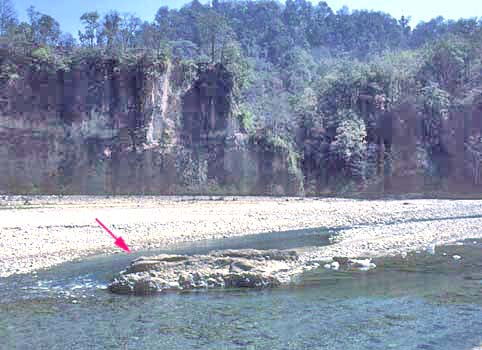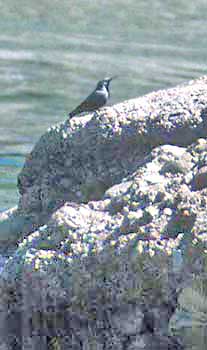
a web page by Don Roberson |
WALLCREEPER Tichodromidae |
||
|
||
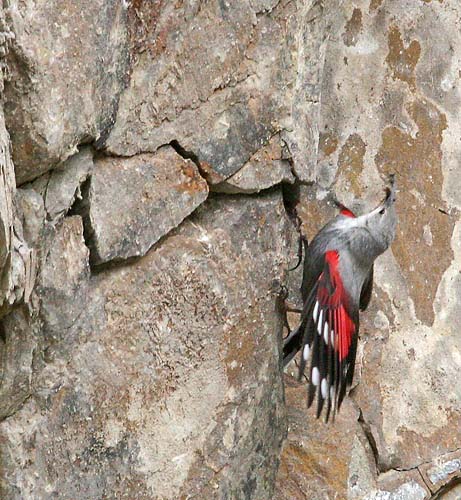 The
Wallcreeper is essentially a rock-climbing, long-billed, insectivorous
nuthatch of remote Eurasian mountains (nice photos of dark-throated
male, below, and female, left, by Brad Schram). It was once considered
related to tree-creepers but anatomical and behavioral evidence argued
it was more like a nuthatch. DNA-DNA hybridization data show a close
relationship with nuthatches; Sibley & Monroe (1990) consider it a
subfamily of the Sittidae (Nuthatches). Voous (1977) placed it in its
own family as "the extraordinary adaptations to extreme mountain
conditions . . . might not immediately have justified the recognition
of a family of its own, but they surely mark the arrival at a new
structural and ecological level with promising possibilities." Birds of the Western Palearctic (Cramp 1993) also placed it in its own monotypic family. The on-going Handbook of the Birds of the World
project will also retain the family when its place in Vol. 13 is
reached. As Wallcreeper is an unusual and special bird, traditionally
considered of family level and as it breaks no taxonomic rules to
retain it as this level, I like the idea of retaining it in its own
family. The
Wallcreeper is essentially a rock-climbing, long-billed, insectivorous
nuthatch of remote Eurasian mountains (nice photos of dark-throated
male, below, and female, left, by Brad Schram). It was once considered
related to tree-creepers but anatomical and behavioral evidence argued
it was more like a nuthatch. DNA-DNA hybridization data show a close
relationship with nuthatches; Sibley & Monroe (1990) consider it a
subfamily of the Sittidae (Nuthatches). Voous (1977) placed it in its
own family as "the extraordinary adaptations to extreme mountain
conditions . . . might not immediately have justified the recognition
of a family of its own, but they surely mark the arrival at a new
structural and ecological level with promising possibilities." Birds of the Western Palearctic (Cramp 1993) also placed it in its own monotypic family. The on-going Handbook of the Birds of the World
project will also retain the family when its place in Vol. 13 is
reached. As Wallcreeper is an unusual and special bird, traditionally
considered of family level and as it breaks no taxonomic rules to
retain it as this level, I like the idea of retaining it in its own
family. |
||
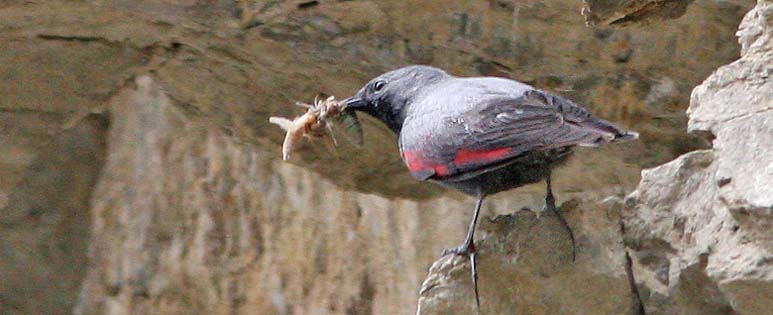 |
||
| Whatever is its true taxonomic level, it is a highly prized bird. Wallcreeper breeds in remote rocky canyons high in the mountains from the Spanish Pyrenees and European Alps (usually 1000–2000m = 3300–6600' elevation) through the Himalayas to China, and it can be elusive and frustrating in its summer haunts. | ||
Harap & Quinn (1995) summarized the Wallcreeper this way in inimitable British lingo: "One of the most spectacular birds in the world, this species is aptly named the 'rock flower' in Chinese. Often nesting in inaccessible mountain retreats, it is a 'Red Letter' bird whenever seen." I had often thought I'd have to undertake a steep hike in the Alps to search this prized species. Indeed, I had always pictured the Reichenbach Falls — where Sherlock Holmes and Professor Moriarty wrestled in Conan Doyle's The Final Problem — when I thought of a Wallcreeper. But it turned out there was another way to see a Wallcreeper. |
||
In winter birds move to lower elevation to inhabit cliffs in quarries, castles, ruins, and boulders in river beds. An example of the latter habitat is the Kosi River in the western Himalayan foothills of India. It was therefore quite exciting to learn that we had a chance — even as late as mid-March — on the Kosi River in India. Efforts at various known sites were initially unsuccessful but our guide, Karan Pradhan, tried the final spot shown above on our way out of Corbett National Park and, as you see, these efforts were crowned with success. The photos (below) show that site and a distant Wallcreeper frequenting an outcrop in the river. |
||
|
||
From an American perspective the Wallcreeper reminds me of a Canyon Wren Catherpes mexicanus. They are fairly close in size and the Canyon Wren is a rock-climbing, long-billed, insectivorous wren. Bill shapes are remarkably similar. Neither use their tail as prop for climbing rocks. The Wallcreeper has spectacular wing patches; the Canyon Wren an loud and beautiful song. Both frequent habitat niches that are similar — steep-walled rocky cliffs and canyons in summer and a wider variety of boulders, cliffs, and ruins in winter. Both occasionally reach the coast and forage on sea cliffs. They are not related; this is but another example of convergent evolution. With its specialized niche, Wallcreeper remains somewhat of an enigma. Harap & Quinn (1995) wrote that "the details of its distribution remain to be worked out, especially in the east." A close-up of a breed male carrying food is shown in this photo (below) by Ron Saldino. |
||
 |
||
Photos: Brad Schram photographed the nesting pair of Wallcreeper Tichodroma muraria on a cliff next to a road north of Xiaojin, western Sichuan, China, in May 2007; the flight shot is also one of those birds. I took the winter habitat shot and the inset Wallcreeper on the Kosi River at Ramnagar, Uttar Pradesh, India, on 17 March 2001. The bottom photo was taken by Ron Saldino near Corbett NP, Uttar Pradesh, India, on 18 March 2001. First 3 photos © 2008 Brad Schram, and final photo © Ron Saldino, all used with permission; all rights reserved. The remaining two shots © Don Roberson. Bibliographic note:
Literature cited:
|
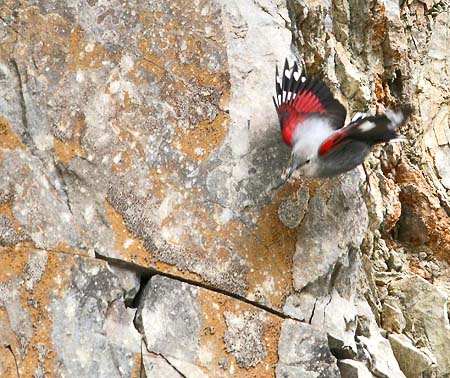 Individuals
can be very dramatic when flying as the spectacular carmine
wing-patches are most apparent in flight (right; another fine shot by
Brad Schram). Otherwise the plumage is sooty-gray but breeding-plumaged
males have black throats.
Individuals
can be very dramatic when flying as the spectacular carmine
wing-patches are most apparent in flight (right; another fine shot by
Brad Schram). Otherwise the plumage is sooty-gray but breeding-plumaged
males have black throats.